Chronic hypoxia augments depolarization-induced Ca2+ sensitization in pulmonary vascular smooth muscle through superoxide-dependent stimulation of RhoA
- PMID: 19897743
- PMCID: PMC2822557
- DOI: 10.1152/ajplung.00276.2009
Chronic hypoxia augments depolarization-induced Ca2+ sensitization in pulmonary vascular smooth muscle through superoxide-dependent stimulation of RhoA
Abstract
Rho kinase (ROCK)-dependent vasoconstriction has been implicated as a major factor in chronic hypoxia (CH)-induced pulmonary hypertension. This component of pulmonary hypertension is associated with arterial myogenicity and increased vasoreactivity to receptor-mediated agonists and depolarizing stimuli resulting from ROCK-dependent myofilament Ca(2+) sensitization. On the basis of separate lines of evidence that CH increases pulmonary arterial superoxide (O(2)(-)) generation and that O(2)(-) stimulates RhoA/ROCK signaling in vascular smooth muscle (VSM), we hypothesized that depolarization-induced O(2)(-) generation mediates enhanced RhoA-dependent Ca(2+) sensitization in pulmonary VSM following CH. To test this hypothesis, we determined effects of the ROCK inhibitor HA-1077 and the O(2)(-)-specific spin trap tiron on vasoconstrictor reactivity to depolarizing concentrations of KCl in isolated lungs and Ca(2+)-permeabilized, pressurized small pulmonary arteries from control and CH (4 wk at 0.5 atm) rats. Using the same vessel preparation, we examined effects of CH on KCl-dependent VSM membrane depolarization and O(2)(-) generation using sharp electrodes and the fluorescent indicator dihydroethidium, respectively. Finally, using a RhoA-GTP pull-down assay, we investigated the contribution of O(2)(-) to depolarization-induced RhoA activation. We found that CH augmented KCl-dependent vasoconstriction through a Ca(2+) sensitization mechanism that was inhibited by HA-1077 and tiron. Furthermore, CH caused VSM membrane depolarization that persisted with increasing concentrations of KCl, enhanced KCl-induced O(2)(-) generation, and augmented depolarization-dependent RhoA activation in a O(2)(-)-dependent manner. These findings reveal a novel mechanistic link between VSM membrane depolarization, O(2)(-) generation, and RhoA activation that mediates enhanced myofilament Ca(2+) sensitization and pulmonary vasoconstriction following CH.
Figures

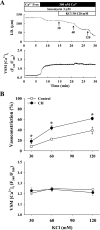
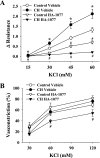
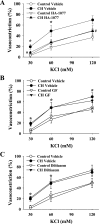

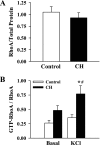
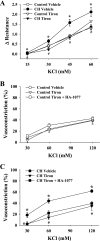
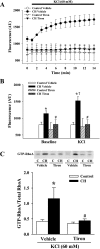
References
-
- Al Mehdi AB, Zhao G, Dodia C, Tozawa K, Costa K, Muzykantov V, Ross C, Blecha F, Dinauer M, Fisher AB. Endothelial NADPH oxidase as the source of oxidants in lungs exposed to ischemia or high K+. Circ Res 83: 730–737, 1998 - PubMed
-
- Barman SA. Vasoconstrictor effect of endothelin-1 on hypertensive pulmonary arterial smooth muscle involves Rho-kinase and protein kinase C. Am J Physiol Lung Cell Mol Physiol 293: L472–L479, 2007 - PubMed
-
- Broughton BR, Walker BR, Resta TC. Chronic hypoxia induces Rho kinase-dependent myogenic tone in small pulmonary arteries. Am J Physiol Lung Cell Mol Physiol 294: L797–L806, 2008 - PubMed
-
- Chan CK, Mak JC, Man RY, Vanhoutte PM. Rho kinase inhibitors prevent endothelium-dependent contractions in the rat aorta. J Pharmacol Exp Ther 329: 820–826, 2009 - PubMed
Publication types
MeSH terms
Substances
Grants and funding
LinkOut - more resources
Full Text Sources
Other Literature Sources
Research Materials
Miscellaneous

